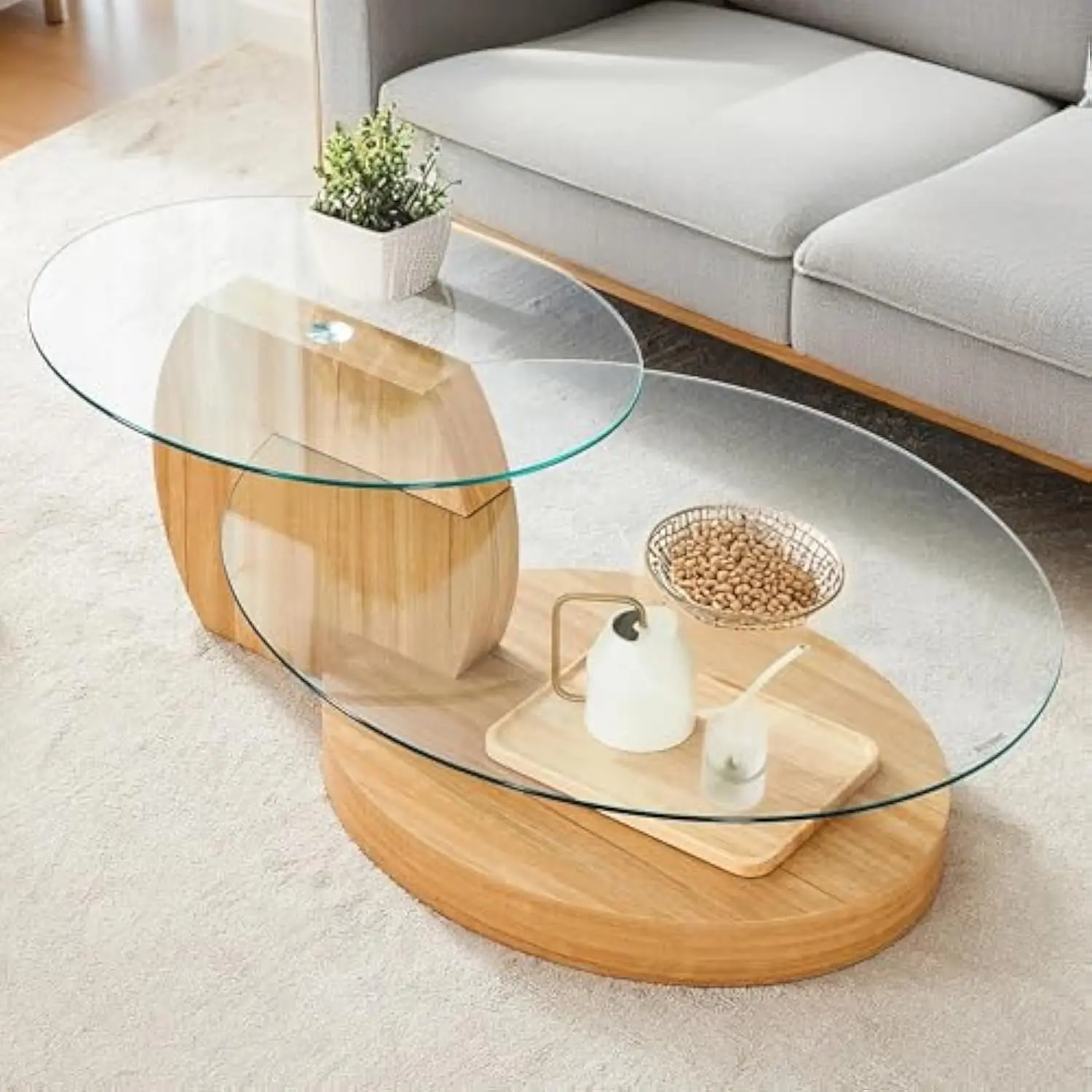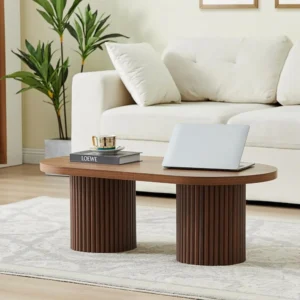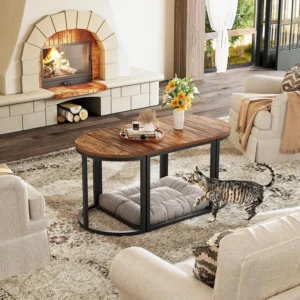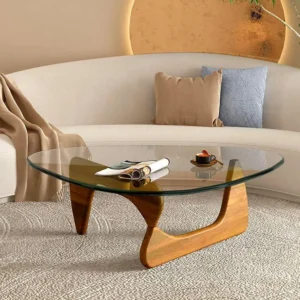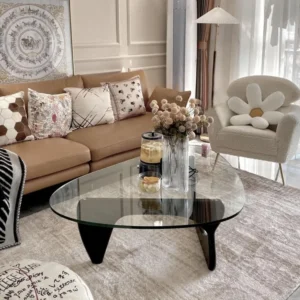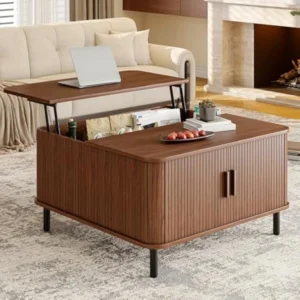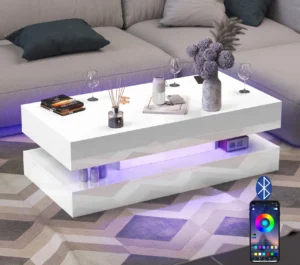Introduction: Optimizing Small Spaces with the Perfect Coffee Table
Furnishing a small living space presents unique challenges, especially when it comes to selecting the right coffee table. Despite limited square footage, this essential piece sits at the heart of your living area, serving as both a functional surface and a style statement. The shape of your coffee table directly impacts not just how well it fits physically, but how spacious your entire room feels.
When working with compact areas, every furniture choice matters. The perfect coffee table balances several crucial factors:
– Shape that complements your room’s layout and traffic flow
– Size proportionate to your seating and available space
– Material that contributes to visual lightness
– Positioning that maximizes functionality without crowding
Finding the right balance can transform a cramped living area into an inviting, functional space. The difference between a coffee table that overwhelms a room and one that enhances it often comes down to understanding how various shapes work within small spaces. Many intelligent black mid-century coffee tables can provide both style and functionality while maximizing black mid-century coffee tables offers practical ways to incorporate these pieces into compact living areas.
Round Coffee Tables: Why Circles Excel in Compact Areas
Round coffee tables are often the first recommendation for small spaces, and for good reason. Their soft, circular edges eliminate sharp corners that can disrupt traffic flow and become painful obstacles in tight quarters. This shape naturally creates better movement patterns as people can easily navigate around the table rather than bumping into angular corners.
The visual effect of round tables can be equally impactful. Their smooth curves soften the appearance of rooms dominated by straight lines and rectangular furniture, creating a more balanced aesthetic. This softening effect isn’t just about looks—it creates the perception of more space by reducing visual interruptions.
Benefits of round coffee tables in small spaces include:
– Improved traffic flow with no sharp corners to navigate around
– Creates a natural gathering point for conversation
– Works exceptionally well with sectional sofas by balancing their angular shape
– Fits easily in apartments and studios where every inch counts
– Perfect for homes with young children due to safety benefits
For most small spaces, look for round tables between 24-36 inches (60-90 cm) in diameter. This size provides useful surface area without overwhelming the room. Our mid-century modern round coffee tables collection features several options perfectly sized for compact living, with slim profiles that maximize function while minimizing visual weight.
Oval Coffee Tables: The Elegant Space-Saving Alternative
Oval coffee tables offer a sophisticated middle ground between round and rectangular options. They maintain the benefit of curved edges for improved flow while providing additional surface area compared to round tables of similar width. This makes them particularly valuable in narrow rooms where you need more usable tabletop but still want to avoid sharp corners.
The elongated shape of oval tables complements longer sofas while maintaining an open feel in the room. Their organic form directs movement around the living space in a natural, flowing pattern rather than forcing rigid pathways. This can make a small room feel more intuitive and less cramped.
For small spaces, look for oval tables between 36-48 inches (90-120 cm) long with a narrow width of around 18-24 inches (45-60 cm). This proportion provides good usability without consuming too much floor space. Many people mistakenly believe oval tables take up more room than rectangular ones, but their rounded ends actually require less clearance space.
The fluid lines of oval coffee tables enhance room flow by creating visual continuity that rectangular tables can’t match. Our mid-century modern oval coffee tables feature tapered legs and slim profiles that further enhance this space-saving effect while maintaining authentic design principles.
Rectangular Coffee Tables: Maximizing Function in Narrow Rooms
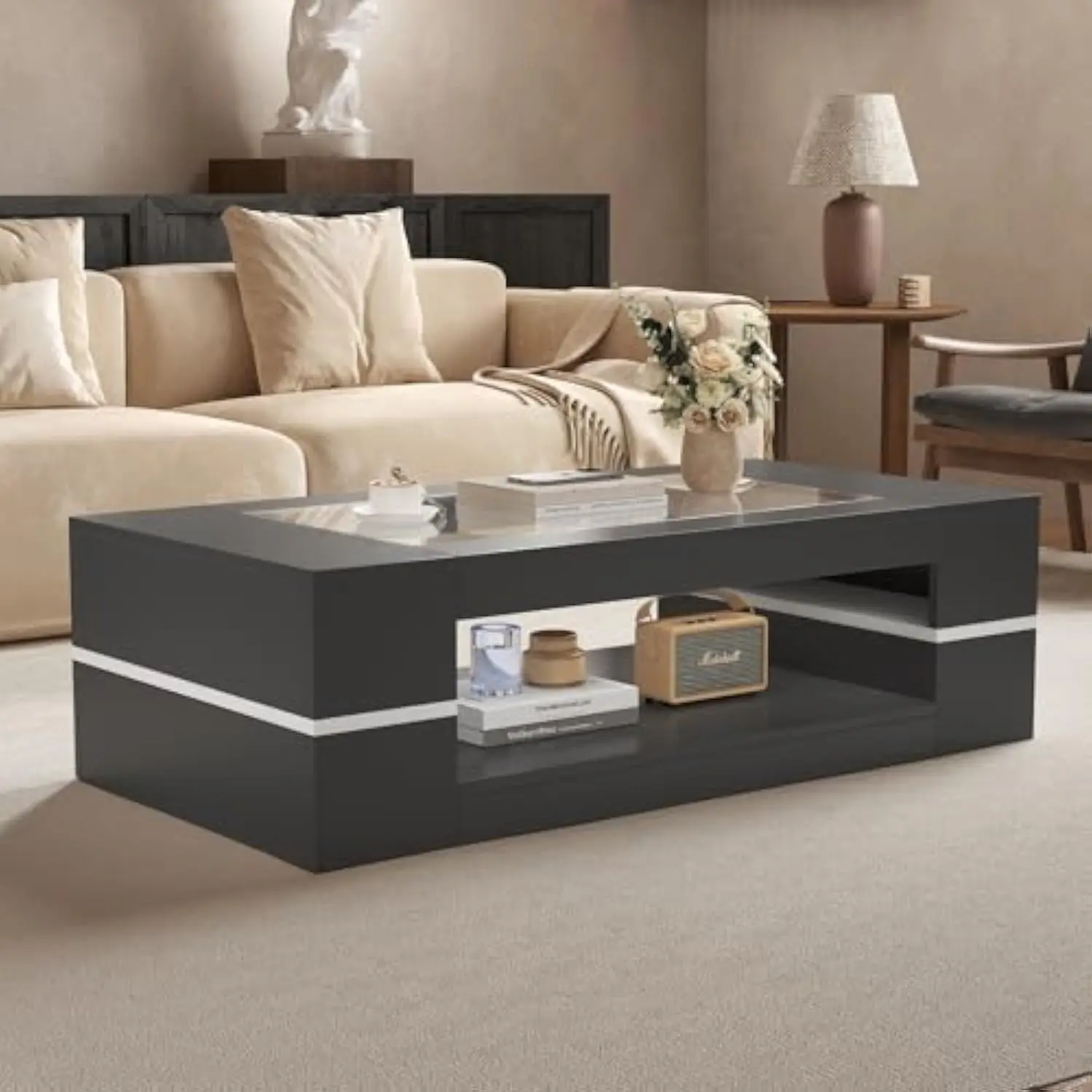
While conventional wisdom often suggests avoiding rectangular coffee tables in small spaces, slim rectangular options can actually work extremely well in certain layouts. Narrow rectangular tables are particularly effective in rooms where the primary seating is a standard sofa against a wall, as they provide maximum surface area within a controlled footprint.
The key to making rectangular tables work in small spaces is proportion. Look for tables with:
– Narrow depth (no more than 18-20 inches/45-50 cm deep)
– Length proportionate to your sofa (approximately two-thirds the length of your sofa)
– Height slightly lower than your sofa seat (typically 16-18 inches/40-45 cm)
– Visual lightness through material choice or construction
When positioning a rectangular table, leave at least 14-18 inches (35-45 cm) between the table and seating to allow comfortable leg room. Avoid common mistakes like choosing tables that are too bulky or too long for the space, which can create awkward traffic patterns.
Our mid-century modern rectangular coffee tables collection includes several narrow options with clean lines and open shelving that provide functionality without visual heaviness—perfect for maximizing surface area in tight quarters.
Square Coffee Tables: Creating Balanced Seating Areas
Square coffee tables excel at creating symmetrical, balanced seating arrangements in small spaces. They’re particularly effective with L-shaped sectional sofas, fitting naturally into the corner created by the sectional while providing equal access from all seats.
The clean, geometric shape of square tables creates a sense of order in compact rooms and can help anchor a conversation area. For small spaces, look for square tables between 24-30 inches (60-75 cm) on each side, which provides adequate surface without overwhelming the room.
Square tables work best when:
– Centered within a conversational seating arrangement
– Paired with an L-shaped sectional, fitting into the inside corner
– Used in rooms where equal access from multiple seating pieces is important
– You need defined boundaries in an open concept small space
When selecting a square table, consider its visual weight carefully. Tables with solid bases can appear heavier than those with open legs. Glass tops or lighter finishes can help minimize this effect. Our mid-century modern square coffee tables feature balanced proportions designed specifically for smaller living spaces, and our square table size guide for small rooms provides additional guidance on selecting the perfect dimensions.
Unique Shapes: Nesting, Asymmetrical, and Multi-Piece Options
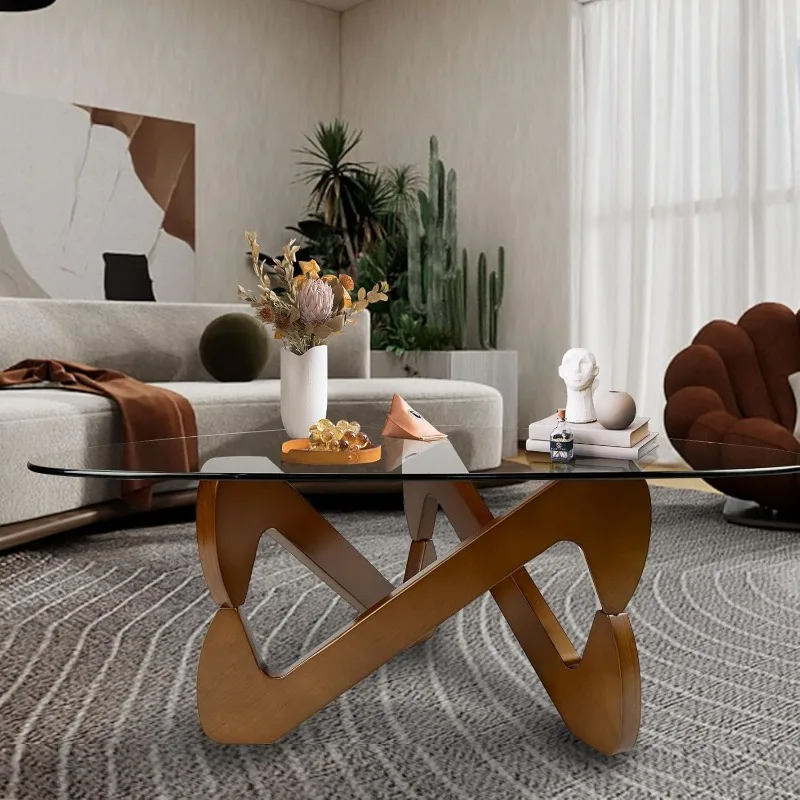
For especially challenging small spaces or unique room layouts, thinking beyond traditional shapes can yield creative solutions. Unique coffee table shapes can address specific space constraints while adding visual interest to your room.
Nesting tables represent one of the most versatile options for small spaces. These tables—typically in graduated sizes—can be separated when needed for entertaining or tucked together when more floor space is required. They provide flexibility that standard coffee tables simply can’t match, which is why maximizing small spaces with nesting coffee tables has become increasingly popular.
Other distinctive options worth considering include:
– Triangular tables that fit neatly into corners or unusual spaces
– Kidney-shaped or asymmetrical tables that create organic flow
– Modular table systems that can be reconfigured as needed
– C-tables that slide under sofas, eliminating clearance concerns
– Geometric or irregular shapes that can fit unique room layouts
These unconventional designs offer solutions for spaces where standard shapes simply won’t work. Our mid-century modern nesting coffee tables provide the flexibility small space dwellers need without compromising on authentic design principles.
Material Matters: Choosing Visually Light Options
The material of your coffee table can be just as important as its shape when creating the perception of space in small rooms. Transparent materials like glass and acrylic create visual openness by allowing the eye to travel through the piece rather than stopping at a solid surface.
Glass-topped tables with slim metal frames provide functional surfaces while maintaining visual lightness. They reflect light throughout the room and don’t interrupt sightlines, making them ideal for compact spaces. Similarly, acrylic or “ghost” tables almost disappear visually while still providing functionality.
When considering materials for small spaces, evaluate:
– Visual weight (transparent materials appear lighter)
– Light reflection (shiny surfaces bounce light, enhancing brightness)
– Color impact (lighter colors recede, darker ones advance)
– Maintenance requirements (especially important in multi-use small spaces)
– Durability needs based on how the table will be used
For small spaces with limited natural light, mirrored elements can help amplify available light while creating the illusion of depth. Our mid-century modern glass-top coffee tables combine authentic design with materials specifically chosen to enhance spaciousness.
Multi-Functional Tables: Storage Solutions for Small Spaces
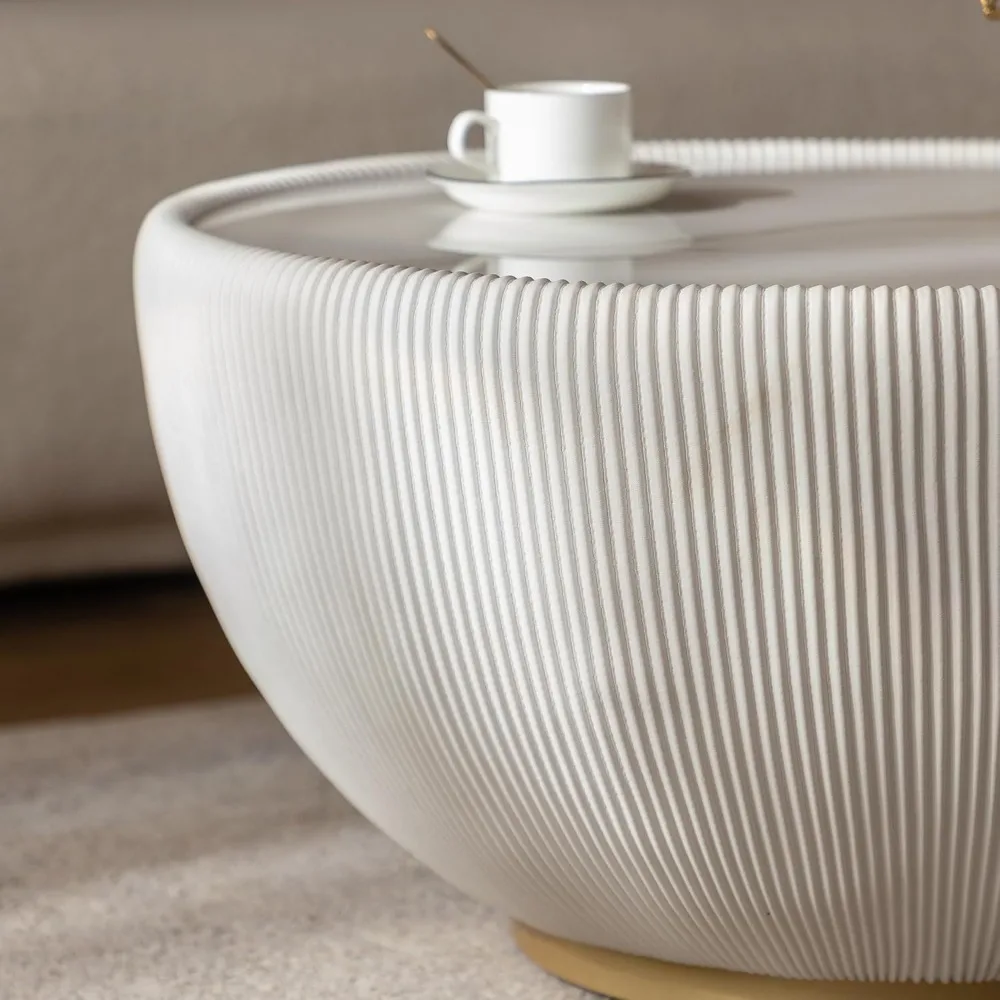
In small spaces, every piece of furniture should earn its keep. Multi-functional coffee tables that provide storage or additional features are particularly valuable in compact living areas where space comes at a premium.
Lift-top coffee tables for small spaces offer dual functionality, providing hidden storage inside plus a surface that raises to create an impromptu workspace or dining area. This versatility makes them especially practical for studio apartments or multi-purpose rooms.
Look for these space-maximizing features:
– Hidden storage compartments for remote controls, magazines, or blankets
– Built-in shelves for displaying books or storing everyday items
– Drawers that keep clutter contained and organized
– Adjustable heights that accommodate different activities
– Nesting components that can be separated when needed
Ottoman coffee tables represent another versatile option, serving triple duty as seating, storage, and surface area with the addition of a tray. Their soft edges make them ideal for tight spaces where traffic flow is a concern.
Mid-Century Modern Danish Coffee Tables, Mid-Century Modern Oval Coffee Tables, Mid-Century Modern Solid Wood Coffee Tables
$390.05 Select options This product has multiple variants. The options may be chosen on the product pageMid-Century Modern Coffee & End Table Sets, Mid-Century Modern Coffee Table Sets, Mid-Century Modern Oval Coffee Tables
Price range: $257.48 through $331.04 Select options This product has multiple variants. The options may be chosen on the product pageMid-Century Modern Glass Top Coffee Tables, Mid-Century Modern Glass Top Side & End Tables
$460.58 Select options This product has multiple variants. The options may be chosen on the product pageMid-Century Modern Glass Top Coffee Tables, Mid-Century Modern Vintage Coffee Tables, Mid-Century Modern Vintage Side & End Tables
$725.36 Select options This product has multiple variants. The options may be chosen on the product pageMid-Century Modern Lift Top Coffee Tables, Mid-Century Modern Square Coffee Tables
$454.73 Select options This product has multiple variants. The options may be chosen on the product pageMid-Century Modern Large Coffee Tables, Mid-Century Modern Rectangular Coffee Tables
$603.26 Select options This product has multiple variants. The options may be chosen on the product page
Our mid-century modern lift-top coffee tables collection at Hearth Forms combines authentic design with practical storage features, proving that functionality doesn’t require compromising style.
Perfect Placement: Arranging Your Coffee Table in a Small Room
Proper coffee table placement is crucial in small spaces where every inch counts. Start by allowing sufficient clearance for comfortable movement—generally 14-18 inches (35-45 cm) between the table and seating. This provides enough space for legs while allowing easy access to both the table surface and the seating.
For traffic pathways around the table, aim for at least 24-30 inches (60-75 cm) of clearance to prevent a cramped feeling and allow people to move freely through the space. In extremely tight quarters, consider whether the table can be offset rather than centered, or positioned to one side to maintain an open walkway.
Alignment with seating is another important consideration. Generally, your coffee table should be:
– Centered with the primary sofa for visual balance
– Proportional in length (roughly two-thirds the length of the sofa)
– Aligned with the front edge of seating or set slightly closer
– At a height slightly lower than the seat height of your sofa
For particularly challenging layouts, explore alternatives like nesting tables, C-tables, or even a pair of small side tables that can be repositioned as needed. Coffee table sizes for small living rooms should be chosen to maintain these clearances while providing functional surface area.
Common Coffee Table Mistakes to Avoid in Small Spaces
Even with the best intentions, choosing a coffee table for a small space can go wrong. Avoid these common pitfalls:
Oversized tables: Selecting tables that are too large, too tall, or too bulky for the space creates obstacles rather than assets. Always measure your available space before purchasing.
Heavy materials: Solid, dark, or visually dense tables make rooms feel smaller and more crowded. Opt for visually lighter alternatives in compact spaces.
Poor proportions: Tables disproportionate to your seating create visual imbalance. Maintain the two-thirds rule for length relative to your sofa.
Cluttered surfaces: Small tables quickly become overwhelmed by items. Be intentional about what you display and incorporate storage options.
Awkward heights: Tables significantly higher or lower than your seating create functional problems. Aim for a height slightly lower than your sofa seat.
Ignoring traffic patterns: Failing to consider how people move through the space leads to constant bumping and awkward navigation. Always prioritize flow.
Style inconsistency: Tables that clash with your existing furniture create visual confusion in small spaces where every piece is prominent.
Finding space-saving coffee tables that avoid these issues while meeting your functional needs will create a more harmonious, usable small living space.
FAQ: Your Small Space Coffee Table Questions Answered
What’s the ideal height for a coffee table in a small space?
The optimal height is typically 16-18 inches (40-45 cm), which is slightly lower than standard sofa seat height. This provides comfortable access without creating a visual barrier in the room.
Are glass coffee tables good for small spaces?
Yes, glass coffee tables are excellent for small spaces because they maintain visual openness and reflect light. They can make a room feel larger, though they do require more frequent cleaning and can show fingerprints.
What’s the minimum clearance needed around a coffee table?
Aim for 14-18 inches (35-45 cm) between the table and seating for leg room, and at least 24 inches (60 cm) for walkways around the furniture arrangement.
What can I use instead of a coffee table in an extremely small space?
Consider nesting tables, C-tables that slide under sofas, wall-mounted drop-leaf surfaces, or even a pair of coordinated side tables that can be moved as needed. Each alternative saves space while maintaining functionality.
How should I style a coffee table in a small room?
Keep styling minimal and purposeful. Follow the rule of three—limiting decorative items to three or fewer, grouped thoughtfully. Consider both function and aesthetics, and avoid cluttering the surface. Incorporating black mid-century coffee table design principles can create visual interest without overwhelming the space.
Summary: Selecting the Perfect Coffee Table Shape for Your Space
Choosing the right coffee table shape for a small space requires balancing practical considerations with aesthetic preferences:
Round tables excel in tight spaces with their smooth corners and improved traffic flow, making them ideal for family homes or apartments with central seating arrangements.
Oval tables offer a perfect compromise with the flowing lines of round tables but more usable surface area, working beautifully with longer sofas.
Rectangular tables (when slim and properly proportioned) work well in narrow rooms or against wall-facing sofas, providing maximum surface with minimal intrusion.
Square tables create balanced, anchored conversation areas, particularly complementing L-shaped sectionals.
Unique shapes like nesting tables, triangular, or asymmetrical designs solve specific space challenges with flexible solutions.
Remember that material choices significantly impact how spacious your room feels, with glass and light-colored options creating an airier impression. Multi-functional tables with storage provide practical solutions that maximize limited square footage.
The process of choosing the perfect coffee table should always prioritize proportion, traffic flow, and functionality while complementing your existing furniture. With these principles in mind, even the smallest living space can feature a coffee table that enhances rather than constrains your daily life.

